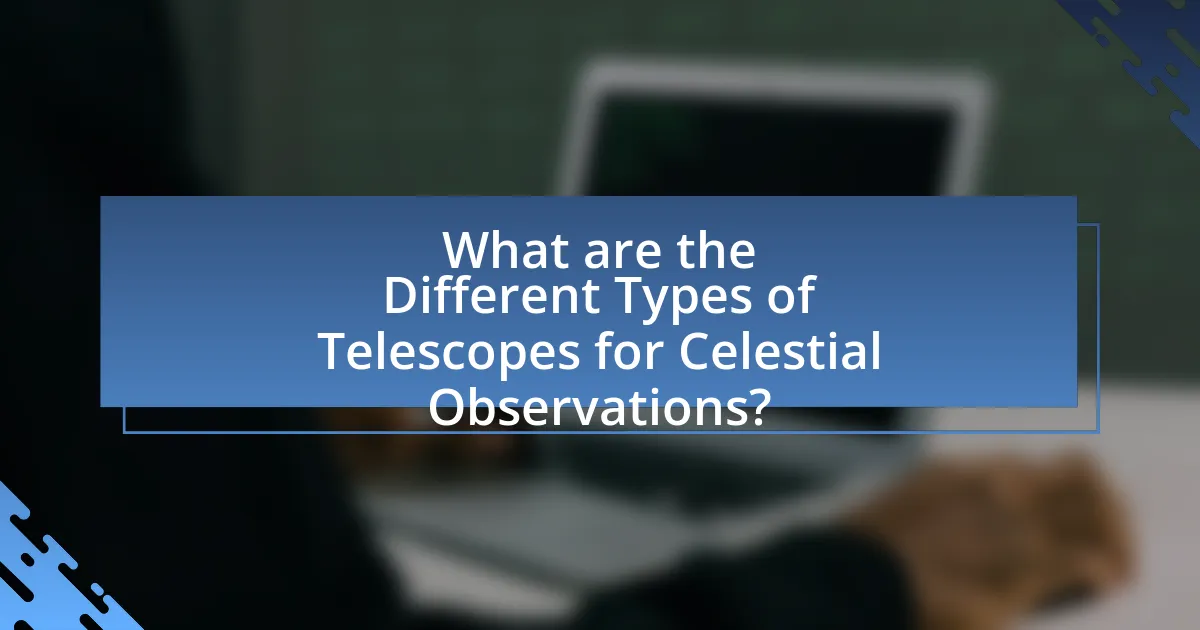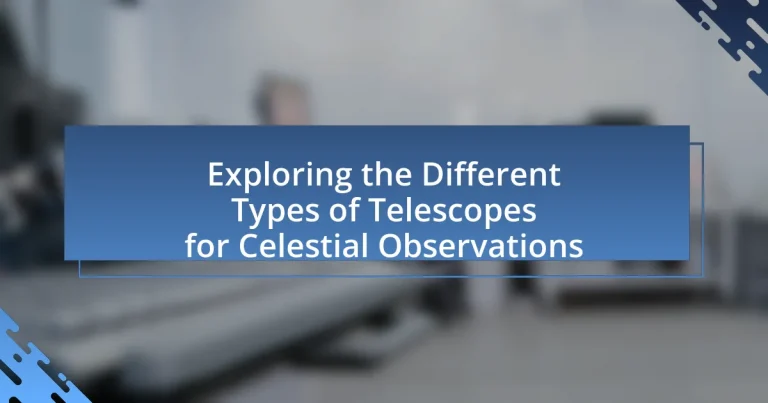The article focuses on the various types of telescopes used for celestial observations, specifically refractor, reflector, and catadioptric telescopes. It outlines how each type functions, their advantages and disadvantages, and their suitability for different astronomical purposes. Additionally, the article discusses the principles behind telescope functionality, the importance of light collection and magnification, and factors to consider when selecting a telescope, including experience level and budget. It also addresses common mistakes to avoid and offers tips for maximizing the use of telescopes in observing celestial phenomena.

What are the Different Types of Telescopes for Celestial Observations?
The different types of telescopes for celestial observations include refractor telescopes, reflector telescopes, and catadioptric telescopes. Refractor telescopes use lenses to bend light and focus images, making them ideal for viewing planets and stars. Reflector telescopes utilize mirrors to gather and focus light, which allows for larger apertures and is effective for deep-sky observations. Catadioptric telescopes combine lenses and mirrors, offering versatility and compact designs, suitable for both planetary and deep-sky viewing. Each type has unique advantages that cater to specific observational needs in astronomy.
How do telescopes enhance our understanding of the universe?
Telescopes enhance our understanding of the universe by allowing astronomers to observe distant celestial objects with greater clarity and detail. They collect and magnify light from stars, galaxies, and other astronomical phenomena, enabling the study of their properties, distances, and compositions. For instance, the Hubble Space Telescope has provided images and data that have led to significant discoveries, such as the acceleration of the universe’s expansion and the existence of exoplanets. These observations are crucial for advancing our knowledge of cosmic evolution and the fundamental laws of physics.
What are the basic principles behind telescope functionality?
Telescopes function primarily based on the principles of light collection and magnification. They utilize lenses or mirrors to gather light from distant celestial objects, focusing it to create a clear image. The refracting telescope employs lenses to bend light, while the reflecting telescope uses mirrors to reflect light. Both types enhance visibility by increasing the apparent size of objects, allowing for detailed observations of astronomical phenomena. The effectiveness of telescopes is supported by the laws of optics, which govern how light behaves when passing through different mediums or reflecting off surfaces.
How do telescopes collect and magnify light from celestial objects?
Telescopes collect and magnify light from celestial objects using lenses or mirrors to gather and focus light. The primary component, either a convex lens in refracting telescopes or a concave mirror in reflecting telescopes, captures light from distant stars and planets. This focused light is then magnified through an eyepiece or camera, allowing for detailed observation. For instance, the Hubble Space Telescope employs a large mirror to collect light from astronomical objects, enabling it to capture high-resolution images of the universe.
What are the main categories of telescopes?
The main categories of telescopes are refracting telescopes, reflecting telescopes, and catadioptric telescopes. Refracting telescopes use lenses to gather and focus light, while reflecting telescopes utilize mirrors for the same purpose. Catadioptric telescopes combine both lenses and mirrors to enhance image quality and portability. These categories are fundamental in astronomy, as they determine the design and functionality of telescopes used for celestial observations.
What distinguishes optical telescopes from radio telescopes?
Optical telescopes and radio telescopes are distinguished primarily by the type of electromagnetic radiation they detect. Optical telescopes capture visible light, allowing them to observe celestial objects in detail, while radio telescopes detect radio waves, enabling them to study phenomena that are not visible in the optical spectrum, such as cosmic microwave background radiation. This fundamental difference in detection leads to varied applications; for instance, optical telescopes are used for detailed imaging of stars and galaxies, whereas radio telescopes are essential for studying pulsars and cosmic events like supernovae.
How do reflecting telescopes differ from refracting telescopes?
Reflecting telescopes use mirrors to gather and focus light, while refracting telescopes use lenses for the same purpose. The primary difference lies in their optical components: reflecting telescopes employ curved mirrors to reflect light and form images, which allows for larger apertures and eliminates chromatic aberration, a common issue in refracting telescopes that use glass lenses. Reflecting telescopes can be built in larger sizes more economically than refractors, making them more suitable for professional astronomical research.

What are the Advantages and Disadvantages of Each Type of Telescope?
The advantages and disadvantages of each type of telescope vary significantly based on their design and intended use. Refractor telescopes provide clear images and require minimal maintenance, but they can be expensive and heavy. Reflector telescopes are generally more affordable and can be built in larger sizes, yet they require regular alignment and maintenance of mirrors. Catadioptric telescopes combine features of both refractors and reflectors, offering versatility and compactness, but they can be complex and costly. Each type serves different observational needs, making the choice dependent on the user’s specific requirements and budget.
What are the benefits of using refracting telescopes?
Refracting telescopes offer several benefits, including high image quality and minimal maintenance requirements. The design of refracting telescopes, which uses lenses to focus light, results in sharp and clear images with excellent color fidelity, making them ideal for observing celestial objects. Additionally, refractors are generally more durable than other types of telescopes, such as reflectors, because they have fewer moving parts and do not require regular alignment. This reliability is particularly advantageous for amateur astronomers and educational purposes, as it allows for consistent performance over time.
How do refracting telescopes perform in terms of image quality?
Refracting telescopes generally provide high image quality due to their use of lenses to focus light. The design minimizes chromatic aberration, especially in well-constructed models, allowing for sharp and clear images of celestial objects. High-quality glass and precise lens shaping enhance the overall performance, making refractors particularly effective for planetary and lunar observations. Historical examples, such as the refracting telescopes used by Galileo and Kepler, demonstrate their capability to produce detailed views of celestial bodies, reinforcing their reputation for superior image quality in astronomy.
What limitations do refracting telescopes have?
Refracting telescopes have several limitations, primarily related to chromatic aberration, size, and cost. Chromatic aberration occurs because different wavelengths of light are refracted by varying amounts, leading to color fringing around objects. Additionally, the physical size of refracting telescopes is constrained by the difficulty in manufacturing large, high-quality lenses, which limits their aperture and light-gathering ability. Furthermore, high-quality refracting telescopes are often more expensive than their reflecting counterparts due to the complexity of lens production. These factors collectively hinder the performance and accessibility of refracting telescopes in astronomical observations.
What are the advantages of reflecting telescopes?
Reflecting telescopes offer several advantages, primarily their ability to eliminate chromatic aberration, which is a common issue in refracting telescopes. This is due to the use of mirrors instead of lenses, allowing for clearer and more accurate images across a wide range of wavelengths. Additionally, reflecting telescopes can be constructed in larger sizes more easily than refractors, enabling the observation of fainter celestial objects. The design of reflecting telescopes also allows for a more compact structure, making them easier to transport and set up. These advantages make reflecting telescopes a preferred choice for both amateur and professional astronomers.
How do reflecting telescopes handle larger apertures?
Reflecting telescopes handle larger apertures by utilizing mirrors to gather and focus light, which allows for the construction of larger optical systems without the weight and distortion issues associated with lenses. The primary mirror in a reflecting telescope can be made much larger than a lens due to the ability to support the mirror from behind, minimizing sagging and optical aberrations. This design enables reflecting telescopes, such as the Hubble Space Telescope with its 2.4-meter mirror, to achieve high-resolution images of distant celestial objects while maintaining structural integrity and optical performance.
What challenges do users face with reflecting telescopes?
Users face several challenges with reflecting telescopes, primarily related to maintenance, alignment, and optical quality. Reflecting telescopes require regular collimation to ensure that the mirrors are properly aligned, which can be a complex and time-consuming process. Additionally, the mirrors can accumulate dust and debris, necessitating cleaning to maintain optimal performance. Users may also encounter issues with optical aberrations, such as coma or astigmatism, which can affect image clarity. These challenges highlight the need for users to have a certain level of technical knowledge and commitment to upkeep for effective use of reflecting telescopes.

How to Choose the Right Telescope for Your Needs?
To choose the right telescope for your needs, first identify your primary interest, whether it’s planetary observation, deep-sky viewing, or astrophotography. Each type of telescope, such as refractors, reflectors, and compound telescopes, serves different purposes; for example, refractors are excellent for viewing planets due to their clarity, while reflectors are better suited for deep-sky objects because of their larger apertures. Additionally, consider factors like portability, budget, and ease of use, as these will influence your overall experience. Research indicates that beginners often benefit from user-friendly models with a stable mount and adequate aperture size, typically around 4 to 6 inches for general use, which balances performance and cost effectively.
What factors should you consider when selecting a telescope?
When selecting a telescope, consider the aperture size, which determines the amount of light the telescope can gather, affecting image brightness and detail. A larger aperture allows for clearer views of celestial objects, making it essential for deep-sky observations. Additionally, evaluate the type of mount, as it influences stability and ease of use; equatorial mounts are preferred for tracking celestial objects, while altazimuth mounts are simpler for beginners. The telescope’s focal length also matters, as it affects magnification and field of view; longer focal lengths provide higher magnification but narrower fields. Lastly, consider portability and budget, as these factors will impact your ability to use the telescope effectively and frequently.
How does your level of experience influence your choice of telescope?
Your level of experience significantly influences your choice of telescope, as beginners typically opt for user-friendly models, while experienced astronomers may select advanced telescopes with greater capabilities. Beginners often prefer refractors or small reflectors that are easy to set up and operate, allowing for immediate use and enjoyment. In contrast, experienced users may choose larger, more complex telescopes, such as advanced reflectors or compound telescopes, which offer enhanced features like computerized tracking and greater light-gathering power for detailed observations. This distinction is supported by the fact that a survey conducted by the American Astronomical Society found that 70% of novice astronomers favor simpler telescopes, while 80% of seasoned astronomers utilize more sophisticated equipment for in-depth celestial studies.
What budget considerations should you keep in mind?
When budgeting for telescopes for celestial observations, consider the total cost, including the telescope, accessories, and maintenance. The price range for telescopes varies significantly, from around $100 for entry-level models to over $10,000 for high-end systems. Additionally, factor in costs for essential accessories such as eyepieces, mounts, and filters, which can add hundreds to thousands of dollars to your budget. Maintenance costs, including potential repairs and upgrades, should also be anticipated, as they can impact long-term investment.
What are some common mistakes to avoid when purchasing a telescope?
Common mistakes to avoid when purchasing a telescope include not considering the type of telescope that best suits your needs, such as refractors, reflectors, or compound telescopes. Many buyers overlook the importance of portability and ease of setup, which can affect the frequency of use. Additionally, failing to check the quality of optics and mount stability can lead to disappointing viewing experiences. It’s also a mistake to ignore the importance of accessories, such as eyepieces and filters, which enhance the overall experience. Lastly, many first-time buyers underestimate the value of researching and reading reviews, which can provide insights into the performance and reliability of specific models.
How can you ensure you are buying the right accessories?
To ensure you are buying the right accessories for telescopes, research compatibility with your specific telescope model and intended use. Accessories such as eyepieces, filters, and mounts must match the specifications of your telescope to enhance performance. For example, using a 1.25-inch eyepiece with a telescope designed for that size will optimize your viewing experience. Additionally, reading reviews and consulting expert recommendations can provide insights into the effectiveness and quality of the accessories. This approach is supported by user feedback on astronomy forums and product reviews, which often highlight the importance of compatibility and quality in enhancing celestial observations.
What should you know about telescope maintenance and care?
Telescope maintenance and care involve regular cleaning, proper storage, and periodic checks of mechanical components. Regularly cleaning the lenses and mirrors with appropriate materials prevents dust and grime from affecting image quality. Proper storage in a dry, temperature-controlled environment protects the telescope from humidity and temperature fluctuations that can cause damage. Additionally, checking the alignment of optical components and ensuring that moving parts function smoothly helps maintain performance. Following these practices ensures longevity and optimal functionality of the telescope, which is crucial for effective celestial observations.
What tips can help you get the most out of your telescope?
To get the most out of your telescope, ensure proper alignment and calibration before use. Accurate alignment allows for precise tracking of celestial objects, enhancing your viewing experience. Additionally, using a stable mount minimizes vibrations, which can blur images. Observing during optimal conditions, such as clear nights with minimal light pollution, significantly improves visibility of celestial details. Regularly cleaning the lenses and mirrors maintains image clarity, while experimenting with different eyepieces can enhance magnification and field of view. These practices are supported by amateur astronomy guidelines, which emphasize the importance of setup and environmental factors in achieving the best observational results.
How can you improve your celestial observation techniques?
To improve celestial observation techniques, utilize high-quality telescopes and enhance your observational skills through practice. High-quality telescopes, such as refractors or reflectors, provide clearer images and better light-gathering capabilities, allowing for more detailed observations of celestial objects. Regular practice in identifying constellations, planets, and other astronomical phenomena increases familiarity and accuracy in observations. Additionally, employing techniques like astrophotography can help capture and analyze celestial events more effectively. Studies show that consistent practice and the use of advanced equipment significantly enhance observational accuracy and enjoyment in astronomy.
What resources are available for learning more about telescope use?
Books, online courses, and astronomy clubs are valuable resources for learning about telescope use. Notable books include “The Backyard Astronomer’s Guide” by Terence Dickinson and Alan Dyer, which provides practical advice on telescope selection and usage. Online platforms like Coursera and Udemy offer courses specifically focused on astronomy and telescope operation, often featuring expert instructors. Additionally, local astronomy clubs frequently host workshops and star parties, allowing hands-on experience with various telescopes and guidance from experienced astronomers. These resources collectively enhance understanding and proficiency in telescope use.


